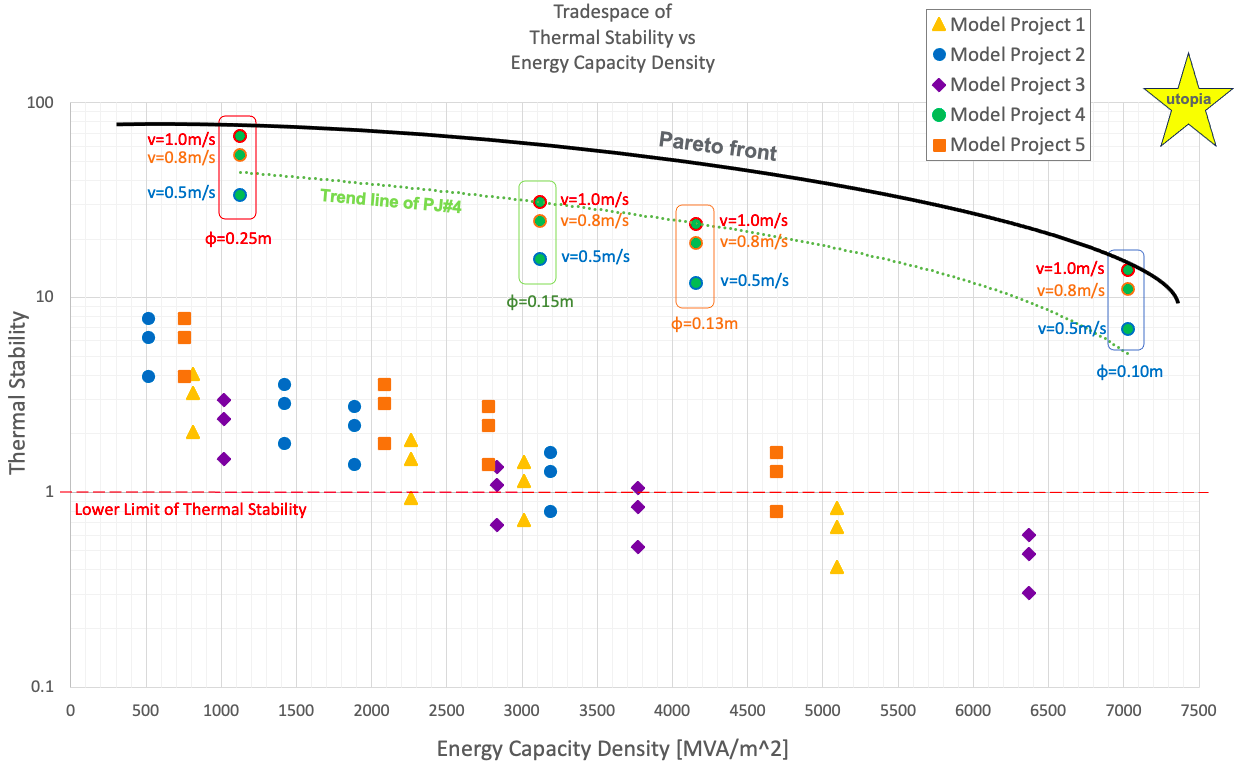Difference between revisions of "Superconducting Cable"
| Line 27: | Line 27: | ||
INSERT DESCRIPTION TABLE (PS2) | INSERT DESCRIPTION TABLE (PS2) | ||
The important FOM trends over time dFOM/dt as well as some of the key governing equations that underpin the technology are summarized as follows: | |||
'''Critical Temperature and operating pressure'''<br /> | |||
The critical temperature (Tc), the most prominent FOM, has been evolved by following some stepping and rising trends. The journey of superconductors began with their discovery in 1911 by Heike Kamerlingh Onnes. Since then, the quest to elevate the critical temperature (Tc) has been relentless. Initially, the focus was on iron-based superconductors, represented by green dots in the following figures. The then governing equation in superconductivity was assumed BCS theory, a fundamental one based on the following equation: | |||
INSERT EQUATION | |||
A monumental shift occurred in 1986 with the emergence of high-temperature superconductors like LaBaCuO, symbolized by blue diamonds, which was beyond the BCS theory and its governing equation. While Nb-based superconductors had a Tc of 20-30K, the high-temperature variant YBCO soared beyond 100K, surpassing even the liquid nitrogen temperature (77K). This achievement held immense practical implications. The subsequent years saw the discovery of superconductors nearing room temperature, though their real-world application is constrained by the need for extremely high pressures, often exceeding 100GPa (i.e., The operating pressure is another FOM of the technology). At present, the critical temperature is found through simulations and experiments, not yet elucidated the governing equations. The following figure shows the historical trends of the critical temperature. | |||
INSERT FIGURE | |||
'''Energy Efficiency Rate'''<br /> | |||
The Energy Efficiency Rate follows the governing equation, which means a higher rate indicates minimal energy losses during transmission. For superconducting cables, the efficiency should ideally be close to 100%, indicating nearly zero energy loss during transmission. While over the years, there has been a consistent effort to improve their performance by following the trends of decreasing loss, especially against challenges such as short circuit faults, the present efficiency is around 95% at best. | |||
INSERT EQUATION | |||
==Alignment with Company Strategic Drivers== | ==Alignment with Company Strategic Drivers== | ||
Revision as of 16:58, 11 October 2023
Technology Roadmap Sections and Deliverables
- 4SC - Superconducting Cable
XXX
Roadmap Overview
TBD
Design Structure Matrix (DSM) Allocation
TBD
Roadmap Model using OPM
We provide an Object-Process-Diagram (OPD) of the 3SC roadmap in the figure below. This diagram captures the main object of the roadmap (Superconducting Cable), including subsystem decompositions such as superconducting material wire and cooling system, and characterizes the Figures of Merits (FOMs) as well as the main processes (transporting) and state changes (electrical current from location A to location B without loss). Note that for room-temperature superconducting cables, the area enclosed by the red dashed-line square can be deleted from the OPD because it does not require the cooling medium.
An Object-Process Language (OPL) of the roadmap scope, which corresponds with the above OPD, is shown as follows:
INSERT OPL
Figures of Merit
The table below shows a list of FOMs by which superconducting cable can be assessed. The FOMs are divided into two groups, compatible with the OPD. Group A shows the FOMs for the superconducting material layer, and Group B shows the FOMs for the superconducting cable, the technology itself we have chosen. To quantify how well a technology performs and how valuable the technology is for the users, it is indispensable to focus on the superconducting material layer, which is critical at the lower level of the system, as well as the cable.
INSERT DESCRIPTION TABLE (PS2)
The important FOM trends over time dFOM/dt as well as some of the key governing equations that underpin the technology are summarized as follows:
Critical Temperature and operating pressure
The critical temperature (Tc), the most prominent FOM, has been evolved by following some stepping and rising trends. The journey of superconductors began with their discovery in 1911 by Heike Kamerlingh Onnes. Since then, the quest to elevate the critical temperature (Tc) has been relentless. Initially, the focus was on iron-based superconductors, represented by green dots in the following figures. The then governing equation in superconductivity was assumed BCS theory, a fundamental one based on the following equation:
INSERT EQUATION
A monumental shift occurred in 1986 with the emergence of high-temperature superconductors like LaBaCuO, symbolized by blue diamonds, which was beyond the BCS theory and its governing equation. While Nb-based superconductors had a Tc of 20-30K, the high-temperature variant YBCO soared beyond 100K, surpassing even the liquid nitrogen temperature (77K). This achievement held immense practical implications. The subsequent years saw the discovery of superconductors nearing room temperature, though their real-world application is constrained by the need for extremely high pressures, often exceeding 100GPa (i.e., The operating pressure is another FOM of the technology). At present, the critical temperature is found through simulations and experiments, not yet elucidated the governing equations. The following figure shows the historical trends of the critical temperature.
INSERT FIGURE
Energy Efficiency Rate
The Energy Efficiency Rate follows the governing equation, which means a higher rate indicates minimal energy losses during transmission. For superconducting cables, the efficiency should ideally be close to 100%, indicating nearly zero energy loss during transmission. While over the years, there has been a consistent effort to improve their performance by following the trends of decreasing loss, especially against challenges such as short circuit faults, the present efficiency is around 95% at best.
INSERT EQUATION
Alignment with Company Strategic Drivers
TBD
Positioning of Company vs. Competition
TBD
Technical Model
TBD
Financial Model
TBD
List of R&D Projects and Prototypes
TBD
Key Publications, Presentations and Patents
TBD
Technology Strategy Statement
TBD
References
TBD
